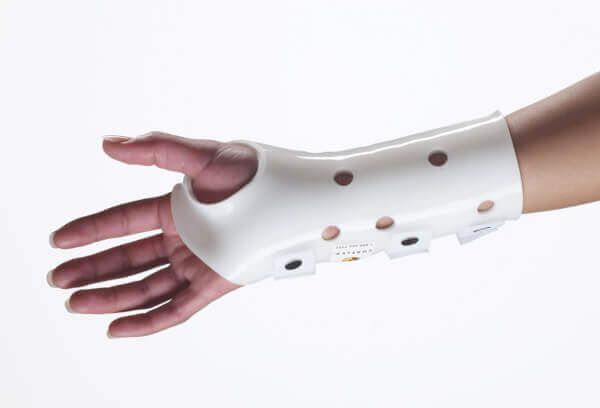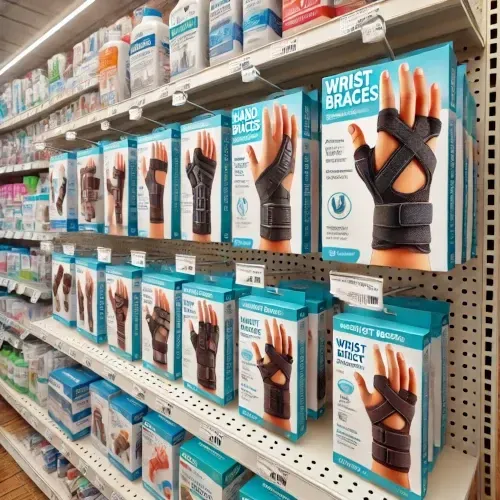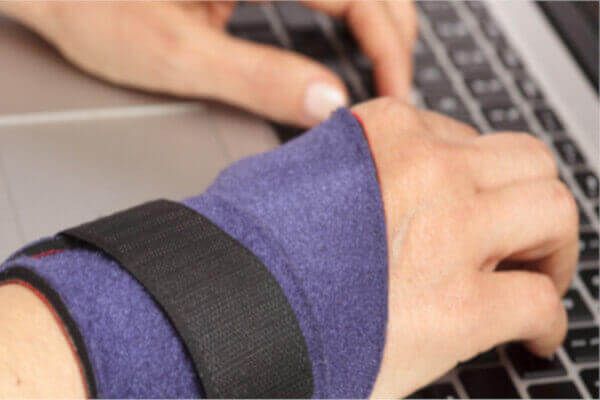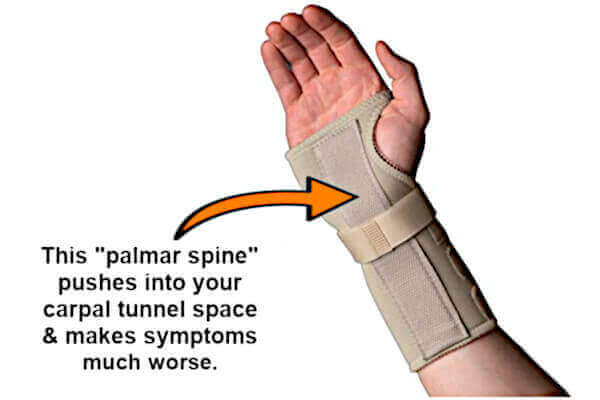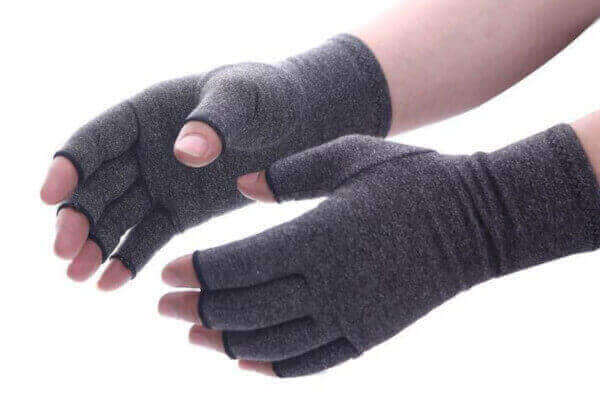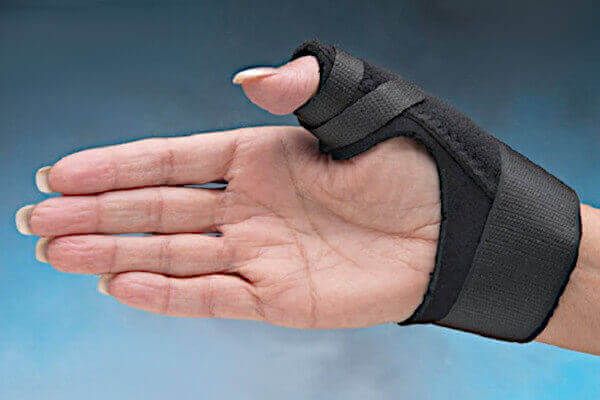Carpal Tunnel Hand Brace: How to Choose the Right One for Fast Relief
A carpal tunnel hand brace holds the wrist in neutral, avoids palm spines and prevents worsening of symptoms—choose carefully.
A hand brace for carpal tunnel should keep the wrist straight, avoid a rigid palmar spine and allow nighttime use without compression. The right brace supports the wrist, drains internal fluid buildup and reduces pressure on the median nerve. Choosing one made specifically for carpal tunnel—not a generic wrist splint—is essential.
Table of Contents
- Overview
- Difference between splints & braces
- The goal of hand bracing
- How to select a carpal tunnel hand brace
- 10 mistakes
using a carpal tunnel hand brace
- Mistake # 1: Using a hand brace for pain relief
- Mistake # 2: Wearing a hand brace while you work
- Mistake # 3: Wearing a hand brace with a palmar spine
- Mistake # 4: Tightly constricting your wrist
- Mistake # 5: Not bracing at night
- Mistake # 6: Assuming expensive braces are better
- Mistake # 7: Believing when the brace advertises “treats carpal tunnel”
- Mistake # 8: Just wearing a hand brace is enough
- Mistake # 9: Having a thumb spica on your hand brace
- Mistake # 10: Blindly following your doctor’s brace advice
- Summary
- FAQs
- About
Overview
By Dr. M. Zannakis | The CarpalRx
If you’re dealing with carpal tunnel pain or numbness, choosing the right hand brace can make all the difference. The key is understanding what your hands actually need for relief — because most braces sold at Walmart, Walgreens, CVS, or even Amazon don’t meet those needs. In fact, the wrong brace can actually make your symptoms worse.
Many people make the mistake of buying “any old wrist brace,” but what you really need is a
carpal tunnel–specific hand brace.
Using the wrong type (or wearing it incorrectly) can keep your pain and
numbness from ever going away — and in some cases, it can make them even more intense.
It’s frustrating — and ironic — because people buy braces to get better, not worse. But the truth is, carpal tunnel treatment requires a very particular kind of support that most generic braces simply don’t provide.
The good news? The right brace, used properly, is one of the most effective ways to relieve carpal tunnel symptoms and start true healing. Below, you’ll learn exactly what to look for in a brace, which common mistakes to avoid, and how to use it correctly to finally get relief.
Difference between splints & braces
Most people use the terms “splint” and “brace” interchangeably. But they actually mean
two different things. Both are considered
medical devices.
- A
splint
is used to completely immobilize a particular joint.
- A
brace
is used to limit the motion of a joint & support it through that movement.
Those two functions are very similar when it comes to the hand and wrist. In fact, the majority of braces and splints perform identical functions. For now, we'll combine them and
refer to them as a “carpal tunnel hand brace”.
The goal of hand bracing
How Severe is Your Carpal Tunnel? Take the Severity Quiz
How to select a carpal tunnel hand brace
Before identifying the biggest mistakes in using a carpal tunnel hand brace, here's what you
must look for.
The best hand brace for treating carpal tunnel syndrome is
certified by carpal tunnel doctors.
Features of a certified carpal tunnel hand brace:
- Made of cloth, not rigid or plastic. (Those are for sprains and fractures.)
- Does
not
have a metal spine on the palm side ("palmar spine").
- Comfortable, because you must sleep with it every night for months.
- Keeps your hand and wrist in a
neutral position (straight).
- Not too tight around your hand and wrist because that can impede
blood flow and
fluid drainage.
- Does not completely immobilize your wrist. (Some movement is necessary to pump out excess fluid from the carpal tunnel space.)
- Easy to put on and remove. Over 80% of patients have
bilateral carpal tunnel syndrome (meaning it occurs on both hands). If so, one hand may fumble while trying to secure a complicated brace on the other hand. Velcro straps make this job easy.
- Washable because it’s worn every night.
- Made of breathable fabric to avoid perspiration.
10 mistakes
using a carpal tunnel hand brace
Mistake # 1: Using a hand brace for pain relief
This is probably the most common mistake in wearing a carpal tunnel brace. And it’s due to a general misconception by doctors and patients alike. That misconception is that hand braces help ease carpal tunnel pain.
In fact, braces are not designed nor intended for carpal tunnel pain relief.
Since hand bending may cause
pain and tissue damage, the brace helps prevent bending. In other words, every carpal tunnel hand brace is designed only to keep your hand from hyper-bending. But it's not like taking Advil for pain.
Note that
some bending is necessary with carpal tunnel, even though it might be painful. This is discussed in
Mistake # 2 below.
It’s also important to know that the vast majority of hand braces are
not designed for use with carpal tunnel syndrome. That's because of how those braces are constructed. (See
Mistake # 3
below.)
Mistake # 2: Wearing a hand brace while you work
Wearing a hand brace to support your wrist is great for conditions like
sprains
and
arthritis. They help you reduce strain when you work which could otherwise cause stress and pain.
But contrary to what
carpal tunnel syndrome doctors usually advise, you should not wear a carpal tunnel hand brace 24/7. In other words, never wear a brace during the daytime as you work.
Completely restricting your wrist while working can be harmful.
Your wrist should
not
be restricted for two reasons.
- First, wearing a hand brace while working makes you subconsciously fight it. You don’t actually sense it, but essentially your hand is doing a lot of mini
isometric exercise (moving against an immovable force). Since carpal tunnel syndrome is a problem with
inflamed tendons, this extra stress is harmful to your already sick tendons. So the hand brace stresses your hand even more than if you didn’t wear it.
- The second reason to not wear a carpal tunnel hand brace while you work is because your wrist needs to bend and move when you have carpal tunnel syndrome. Bending is the
only way the body can pump out
excess fluid build-up from inside the wrist joint. (See
Mistake # 4 below.)
Fluid build-up is what causes pressure deep inside the wrist joint, eventually crushing the
median nerve. That’s what gives you symptoms like
pain and numbness with carpal tunnel syndrome. Drain the fluid and you relieve the pressure.
Mistake # 3: Wearing a hand brace with a palmar spine
Nearly all hand braces have a "palmar spine". That’s the metal stiffener on the palm side of the brace. It’s a good feature to have if you suffer from a sprained wrist or arthritis. In those cases, you need to restrict wrist movement in order to avoid pain.
But if you have carpal tunnel syndrome, you might as well let someone stand on your wrist. That metal spine only serves to damage the interior of your wrist joint and further increase internal pressure.
How does the metal spine increase pressure? It happens when we bend our hand backward (i.e., extending the wrist joint).
With a metal spine there, bending the wrist backward will press that spine into your
carpal tunnel space. As a result, the pressing will increase pressure inside the wrist. And increased pressure means more compression of the median nerve, which causes more pain and numbness.
After sleeping with this kind of carpal tunnel hand brace, many patents wake up in the morning with an
even more painful or tingly hand. That spine is the likely reason why.
Unfortunately, if you simply remove the spine from the brace, it loses rigidity and stability.
A certified carpal tunnel hand brace is sturdy without having a spine on the palm side.
Mistake # 4: Tightly constricting your wrist
As discussed in
Mistake # 2
above, restricting you wrist movement while working when you have carpal tunnel syndrome is harmful. Your hand tends to fight the restriction, and that’s bad for your already strained tendons.
Also, free joint movement is the only way the body can pump excess fluid out & away from a joint. With carpal tunnel syndrome,
inflamed tendons cause fluid build-up deep inside the wrist. That excess fluid is the
root cause of carpal tunnel syndrome, and must be allowed to drain away. If it doesn’t, the fluid simply builds up and
causes more damage.
In addition, if you have carpal tunnel syndrome, tight constriction impedes blood flow in the joint. The tighter the constriction, the less blood gets in (and the less fluid is able to drain out).
A certified carpal tunnel hand brace will not constrict your hand or wrist.
Mistake # 5: Not bracing at night
Now we know if you have carpal tunnel, bracing your hand during the daytime is harmful. In contrast, you
absolutely must wear a hand brace when you sleep.
When we sleep, we unconsciously bend our hands. Some people keep their hands bent forward while others keep them bent backward. And you can maintain this position for several hours at a time.
That's very harmful.
If you have carpal tunnel syndrome,
any hyper-bending of the wrist is bad. That’s because it constricts the carpal tunnel space, which adds pressure to the median nerve. And that’s why it’s important to brace your hand in a neutral (straight) position while you sleep.
As discussed above, wearing a hand brace at night with a metal spine is doubly harmful. Bending the hand backward is bad enough. But the metal spine will also force itself against your wrist joint. That greatly increases the pressure inside your wrist.
Therefore, you must brace at night. And you must make sure there's
NO metal spine on the palmar surface of the carpal tunnel hand brace you sleep with.
Mistake # 6: Assuming expensive braces are better
Every day, I can count on at least one patient telling me,
“I wanted a good brace, so I bought one for $400.”
My response is always,
“I hope you saved the receipt….return it!”
I’m a veteran brace designer and I know braces inside and out. I've never seen good justification for buying a $400 brace compared to a $50 brace. Basically, braces are like spoons; the cheaper do the same thing as the expensive ones. But again,
no braces sold in pharmacies are designed for carpal tunnel syndrome.
That means the very low-end, cheap, generic, discount store braces you buy from CVS, Walgreens, Wal-Mart, etc. are
not a certified carpal tunnel hand brace. They're
mass-produced in Asia for pennies and sell in the USA for under $25. Those hand braces re almost always inferior in quality and workmanship. Most of them won’t last through more than a couple washes, and don’t provide good joint support. Also, they're usually uncomfortable or irritating. Most importantly, they are
NOT certified by carpal tunnel doctors.
The vast majority of good quality generic braces sell between $30 and $60. But no matter the price, what makes a brace “good quality” is its construction
and the features you need for your particular condition.
Without being repetitive, such good quality braces may be great for a sprain, but they likely
are not designed for carpal tunnel syndrome. (See
Mistake # 7
below.)
Mistake # 7: Believing when the brace advertises “treats carpal tunnel”
Many brace manufacturers use the same brace design for every condition you can imagine: sprains, arthritis, and even carpal tunnel syndrome. But nearly all of these manufacturers fail to understand that carpal tunnel syndrome has unique issues which are
incompatible
with treating sprains, arthritis, etc.
Therefore, if the brace package states
“treats carpal tunnel syndrome”, then be skeptical. Look for the specific features described below. These features are what constitutes a
certified carpal tunnel hand brace. (The main feature: it should not have a palmar spine.)
The 9 currently known certified carpal tunnel braces are listed here.
About compression gloves and carpal tunnel bracelets
On a related issue, never make the mistake of using a
compression glove as a carpal tunnel brace. It will simply restrict blood flow and impede fluid drainage.
There are NO compression gloves manufactured today that can treat carpal tunnel syndrome. Again, if the compression glove packaging says
"treats carpal tunnel" then steer clear.
Also, a
carpal tunnel bracelet is worthless and ineffective. There is no evidence whatsoever that copper or magnetic bracelets provide help for carpal tunnel syndrome.
They'll relieve you of your money but not your pain.
Mistake # 8: Just wearing a hand brace is enough
A common mistake carpal tunnel sufferers make is thinking that just slapping on any old hand brace will make symptoms go away.
It usually won’t.
Night bracing is just
one
component of an
arsenal of remedies that must be used
in tandem
to support each other.
For instance, with
mild stage carpal tunnel syndrome, using a night brace might be enough. It usually is.
But with
moderate stage carpal tunnel syndrome you must
also incorporate daily stretching exercises for your fingers and hands. You don’t have to spend hours doing them. I've created excellent stretching exercises that take only 30 seconds to do for every half hour you work.
They're amazingly effective!
However, if you have
severe stage carpal tunnel syndrome, you must do more. It’s important to incorporate myofascial release massage
in addition to bracing and exercises. Unfortunately, you cannot easily perform
myofascial release massage on yourself because you need 2 hands to do it. Therefore, find a willing and able partner who can help. You need this therapy a minimum of once daily for about 30 days along with a nightly carpal tunnel hand brace and regular stretching exercises.
Mistake # 9: Having a thumb spica on your hand brace
A certified brace for carpal tunnel syndrome will not have a thumb spica.
A thumb spica is a stiff support for the thumb. It is necessary for thumb sprains or fractures. The thumb spica is also useful for
de Quervain’s tenosynovitis. That’s a condition caused by inflammation of the tendons controlling thumb extension.
When such disorders make thumb movement painful, the thumb joint needs rest while the other fingers work. In that case, a brace with a thumb spica is perfect. However, if you don’t have thumb issues, the thumb spica is not necessary.
Unfortunately, many people with carpal tunnel syndrome use a brace with a thumb spica. That’s because carpal tunnel syndrome often causes pain more in the thumb and first finger. So immobilizing the thumb sounds like a good idea, but it’s not. Wearing a thumb spica to restrict thumb movement is harmful for all of the reasons given in
Mistakes #2 & 4
above.
Mistake # 10: Blindly following your doctor’s brace advice
Very few doctors
are uncaring about their patients. Most doctors go to their clinic, see as many patients as they can, and follow what the mainstream does.
Unfortunately, the mainstream is not always right. That’s because the majority of conventional wisdom does not keep pace with the ever-advancing science of medicine.
The best example is when doctors advise carpal tunnel patients to
“just wear a hand brace” 24/7". While that’s good advice for most hand problems like arthritis, sprains or fractures - it's not good advice for carpal tunnel syndrome.
Many general practitioners simply don’t understand the nuances of treating carpal tunnel syndrome. And they don’t appreciate the special physiological circumstances that makes ordinary bracing painful or even harmful.
Therefore, if your doctor advises that you wear any old carpal tunnel hand brace (especially 24/7), then pause. He or she is probably
not
up to date with the science of carpal tunnel syndrome.
But after reading this article, you probably know more about bracing than most healthcare professionals!
Summary
A
carpal tunnel hand brace is one of the simplest and most effective ways to relieve wrist pain, tingling, and numbness caused by carpal tunnel syndrome. The right brace keeps your wrist in a neutral position, allowing the median nerve to recover while you rest or sleep. Choosing a brace designed specifically for carpal tunnel—not a generic pharmacy version—can make a huge difference in comfort and results. Medical-grade options like the
CarpalRx Night Brace are proven to help reduce symptoms quickly and safely.
FAQs
1. What does a carpal tunnel hand brace do?
A
carpal tunnel hand brace keeps your wrist in a neutral position to reduce pressure on the median nerve. This helps relieve pain, tingling, and numbness—especially at night when symptoms are often worse.
2. Can I wear a carpal tunnel hand brace all day?
Yes, but most patients benefit from wearing it mainly during activities that trigger symptoms or while sleeping. Wearing it too long during the day can sometimes weaken wrist muscles, so balance is key.
3. Which type of carpal tunnel hand brace works best?
The best
carpal tunnel hand brace is lightweight, comfortable, and holds your wrist straight without a rigid metal spine pressing into your palm. Certified medical braces—like the
CarpalRx Night Brace—are specifically designed for safe, effective symptom relief.
About


